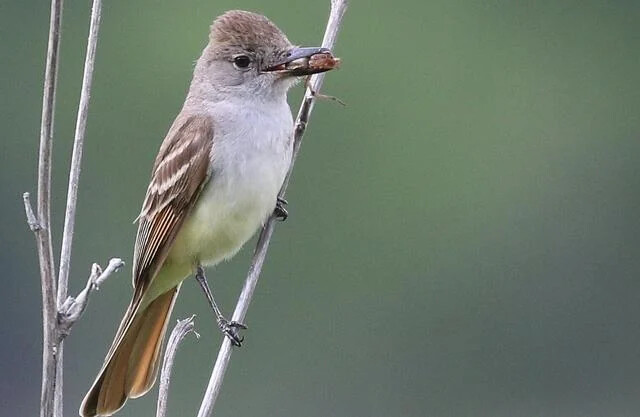Image

By: Alonso Abugattas, Bay Journal

They are the “tyrants” of the treetops — though, unless you’re a bug, you might not see them as particularly tyrannical. I’m referring to the bird family Tyrannidae, the so-called tyrant flycatchers.
It’s the largest bird family in the world, with more than 400 species in the Western Hemisphere, where they are exclusively found. The vast majority live in Central and South America, but we have about 30 species on our continent. One of the most common in the central and eastern U.S., in the spring and summer, is the great crested flycatcher (Myiarchus cristatus).
In addition to being the only crested flycatcher in the eastern U.S., it’s also our only cavity-nesting flycatcher. It’s a secondary cavity nester, which means it doesn’t dig its own holes. Instead, it finds existing cavities — either natural ones in dead trees or those created and left up for grabs by woodpeckers.
It’s a fairly large bird, as flycatchers go — about 8 inches from beak to tail — and it’s also one of the most colorful of its local counterparts, with a bright yellow belly, olive brown or dark gray head, and pale gray throat and chest. It has a bright reddish-brown tail and wings, which are especially noticeable when the bird is in flight. The males and females are of similar plumage and build: long and lean, with broad shoulders and large heads.
Despite the name, the bird’s bushy crest is not always evident, appearing most often when it is alarmed, curious or defending territory.
Despite great crested flycatchers’ tolerance of people, their size and colorful plumage, they’re not easy to spot, because they spend much of their time high in the tree canopy.
It’s their powerful call that gives them away.
It’s a raspy wreep, followed by a burst of as many as a dozen similar but shorter sounds. They are most vocal May through June but start to quiet down from July onward.
Like all tyrant flycatchers, these are skilled fliers. According to ornithologists Wesley Lanyon and Karl Miller, authors of the Cornell Lab of Ornithology’s profile on the species, great crested flycatchers have three hunting styles, which they employ in roughly equal measure. From a perch on a branch, they’ll dart out to catch a flying insect in midair (called sallying); they’ll hover momentarily close to foliage or bark to snatch insects off the surface (hover gleaning); or they’ll dive to the ground to catch terrestrial crawlers.
They also feed on lizards and other small creatures, and, like most birds, they supplement their diet with fruits and berries, particularly in their winter grounds.
A great crested flycatcher is the only cavity-nesting flycatcher species in the eastern U.S. (Andy Reago and Chrissy McLarren/CC BY 2.0)
These birds prefer edge habitats, open woodlands and mixed forests, usually avoiding dense woods. They tend to find natural cavities in deciduous trees. In conifers they are more likely to nest in abandoned woodpecker excavations, according to Cornell.
From early May through July, their breeding season, they spread across most of the central and eastern U.S. and into southern Canada, making it one of the more widespread flycatcher species.
Come September, they’ll head back south, sometimes going only as far as Florida, although most go much farther to southern Central America and even Columbia and Venezuela. They have been known to occasionally show up in places as far as the West Coast and the Caribbean.
Whether they’re coming or going, they normally migrate at night, making them more susceptible to fatal collisions with tall buildings and utility towers.
The first order of business this time of year is finding a suitable cavity to nest in. This is not an easy task because they’re competing with other secondary nesters, such as tree swallows, house wrens, bluebirds, starlings, even squirrels.
Being tolerant of people, great crested flycatchers readily accept nest boxes, as well as incidental human infrastructure, from mailboxes to rain gutters and open pipes. They’ve even been found nesting in the barrel of a cannon at a historic park.
Even though males arrive at the breeding grounds a week or so ahead of their mates, females choose the nesting site — often the same site as the previous year’s and often, but not always, mating with the same male.
The female is the nest builder, employing a messy mix of twigs, grasses, fur, feathers, human trash — and frequently snakeskin sheds. One thought is that the use of snakeskin is meant to ward off predators. Others speculate that the female just likes having “crinkly” stuff in the nest, which would also explain her use of clear plastic wrap and onion skin.
The female lays four to eight eggs (typically five), usually one per day, then incubates them for about two weeks.
Both parents feed the hatchlings, though the male does it less frequently. Much of his time is spent aggressively defending the nest from predators and brood parasites. That may explain why cowbird parasitism is rare with these flycatchers. Their chicks fledge two to three weeks after hatching. Unlike their parents, they will not likely return to the same breeding ground the next year.
These birds fledge only one brood per season — although in the case of nest failure, usually by predation, they will rebuild a nest or start a new one, sometimes repeatedly, in a given season.
Because of their tolerance for being around people, great crested flycatchers have done well. They were more common a century ago, but the population stabilized in the late 1900s and is now estimated at close to 9 million, making it a species of least conservation concern, especially with its large geographic range.
Alonso Abugattas, a storyteller and blogger known as the Capital Naturalist, is the natural resources manager for Arlington County (VA) Parks and Recreation. You can follow him on the Capital Naturalist Facebook page and read his blog at capitalnaturalist.blogspot.com.